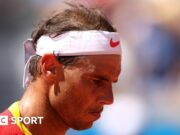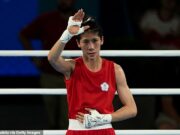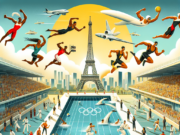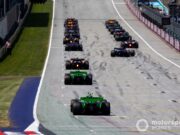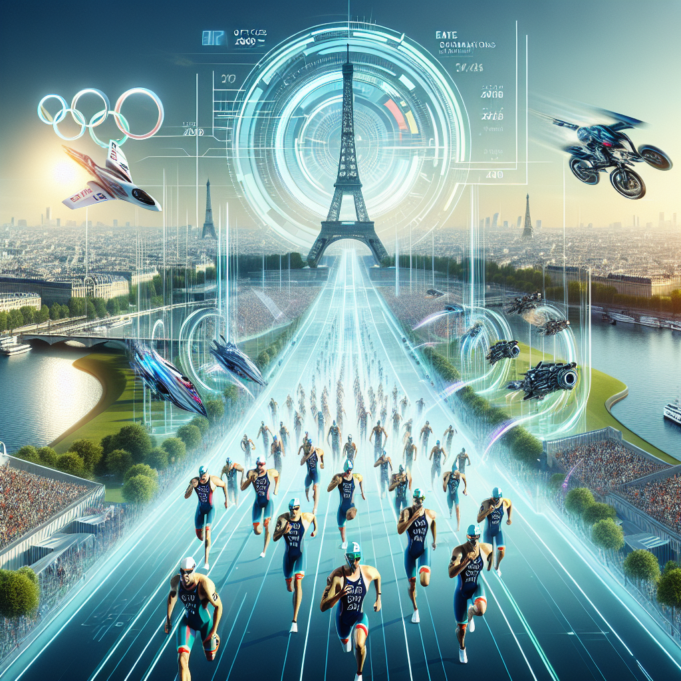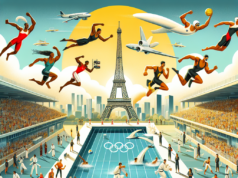Citius, altius, antibioticus. On a humid Wednesday morning in the 8th arrondissement, Paris 2024 set the stage for what is, subtly but evidently, the highlight of France’s Olympic undertaking.
The triathlon events for both women and men took place in a loop, consistently returning to the breathtaking Pont Alexandre III — also known as the bridge from that Sopranos episode — passing by Champs Élysées, Grand Palais, and the western view of the Seine.
Ultimately, it was a true victory, a race traversing water, cycle pathways, and Parisian cobblestones that surely had Emmanuel Macron celebrating in his Élysée office, as the significance extended far beyond the stunning sight of Cassandre Beaugrand winning gold for France in the women’s event.
First and foremost, simply the fact that it occurred at all. By early afternoon, murmurs of conspiracy began circulating regarding actions taken to ensure the event could go ahead, as eyebrows were raised at how, following days of alarming pollution levels, discussions of cancellation, and the political catastrophe of being branded the sewer Games, pathogen levels dipped just enough for the event to proceed. Sometimes, after investing $1.5 billion in your de-pollution initiative, fortune smiles upon you.
The male competitors emerge from the Seine after the swimming segment of the triathlon. Photograph: Tom Jenkins/The Guardian
Secondly, this event was a visual marvel, an impossibly stunning and radiant occasion, a moment for Paris to show off its charm, prompting admiration for the beauty crafted by human hands.
Thirdly, it marked a sporting achievement for the Games. Three hours after Beaugrand’s triumph, Alex Yee from Brockley executed a remarkable sprint finish at the end of a 10km run over ankle-jarring cobbles, collapsing at the finish line to secure a gold medal for Team GB. Observing the strain etched on the athletes’ faces and bodies, this surely stood as one of the most remarkable displays of sporting endurance witnessed, encapsulating the essence of the Games.
Lastly, and most significantly, this was a victory of perception. What transpired here, exactly? One hundred and fifty individuals cycling in tight clothing? The most grueling endurance event since the opening ceremony last Friday?
When stepping back, Wednesday morning’s triathlon resembled a government-sanctioned extinction rebellion unfolding right before our eyes. In the limelight, the Games, the competitors, the progressive mayor Anne Hidalgo, and an unsuspecting International Olympic Committee orchestrated a direct urban intervention. Close down the roads. Capture the world’s gaze. Cycle, swim, reclaim the streets. Finish up exhausted on the curb, carried away by personnel in high-visibility jackets.
One unnoticed benefit of Paris 2024 is that the closure of roads, expansion of cycling paths, and creation of urban walkways have fostered a delightfully improved version of the city. The triathlon transformed that into a sporting occasion, showcasing environmentally friendly urban travel, all brought to life by spirited champions in trainers and two-piece swimwear.
The pre-Olympic bragging about the condition of the Seine always had a touch of amusing myopia. For British media, this seemed like yet another classic occasion to mock the French, framed as just another continental bathroom issue, reminiscent of Bidet Panic and the long-drop latrine discussions of the 1980s. Cleaning a river now? What will these oddities think of next?
The three women’s medallists Cassandre Beaugrand (centre), Julie Derron (left), and Beth Potter share a selfie on the podium. Photograph: Tom Jenkins/The Guardian
In reality, waterways in every nation are clogged with sewage, especially in Britain, where the negligence of privatized water companies, the rise in sewage overflow, and the unsafe state of lakes and rivers is a scandal of enormous proportions. The most fundamental of human necessities, an element we are essentially composed of, is being sacrificed for the sake of shareholders.
Given this context, does attempting to purify the Seine still seem so absurd? There’s considerable scoffing regarding the €1.5 billion allocated to this endeavor. But how do we define the true value of this? At what point does ensuring a clean river become unaffordable? Massive events are frequently accompanied by chatter about legacy and regeneration, terms often utilized merely as sales pitches. Nevertheless, cleaning the Seine undoubtedly stands as the most positive outcome of Paris 2024. What better legacy exists than a reminder not to pollute rivers?
The current challenge lies in preserving this beyond the fleeting two-week television spectacle. This is where the perception aspects emerge. The insistence on hosting swimming events in the Seine might have appeared stubborn. It could still conclude as a misguided decision. Team GB’s athletes have already received their hepatitis vaccinations and are set to undergo a course of antibiotics. The potential consequences of contaminated river water combined with injuries from crashes, wipeouts, and falls on the cobblestones remain unclear.
after newsletter promotion
Yet, the essence was captured in the spectacle. At times, watching the transitions between events, with competitors in swimsuits hopping on and off bikes, then sprinting across the cobbles, resembled the world’s worst commute or a surreal daydream of presenting in front of a board while stark naked. What is the point of this profoundly moving exhibition of human determination, other than to assert that, at times, some endeavors are simply worth pursuing?
The Seine is, after all, the very reason for Paris’s existence. The Romans established it as a trade route. The Vikings raided it. France’s belle époque flourished along its banks. The very river water that athletes ingested also contains the ashes of Jean d’Arc and remnants from the Second World War.
Women competitors race over the Seine during the cycling segment of the event. Photograph: Tom Jenkins/The Guardian
Moreover, like every grand old-world city, Paris is constructed upon a network of inherited tunnels. The primary focus of this Olympic cycle has been the construction of a vast rainwater reservoir. The existing Napoleonic system facilitates the flow of rainwater and wastewater through the same pipes, leading to toxic overflows during heavy rainfall.
Climate change only complicates matters. Speaking of which, Paris aims to open 26 swimming pools along the Seine, partly in response to the pressing question of how to thrive in this city as summer temperatures rise. Public swimming. Improved fish reserves and river vegetation. This is the vision. Whether or not it materializes is uncertain. Hidalgo faces mounting pressure regarding her anti-car measures. But does that truly sound so negative? Paris is effectively highlighting a challenge shared by urban centers worldwide.
And so, for at least one morning, the triathlon — which included swimming, cycling, and running — felt like the heart of the Games. It was stunning, from the silvery light gracing the Seine at dawn to the sunlight breaking through clouds as runners emerged, dripping with river weeds and silt, engaged in what could be described as an amphibious parkour. By the conclusion, it seemed evident that everyone participating in this event warranted some form of medal, not to mention a regimen of antibiotics and a typhoid vaccination.
Paris 2024 articulated its message here. The next challenge is to uphold that image. And for Macron, to realize his aspiration of swimming in the newly purified Seine, a goal that Jacques Chirac also cherished but never saw fulfilled. There’s no better time than now, M President. L’effluente, c’est moi.







